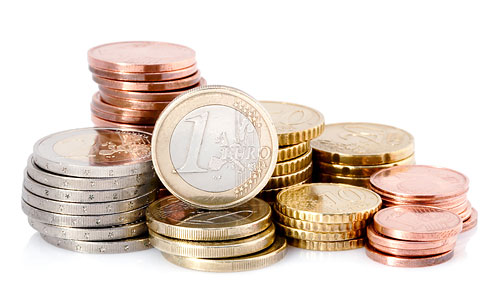On January 1, 2002, the euro was introduced as the legal tender of twelve member states of the European Union (EU). It was the biggest cash changeover in history and an unprecedented challenge – which was mastered superbly. Within a few days, billions of new banknotes and coins came into circulation.
The euro – 10 years old
The banknote printers had been producing the initial supply of just under 15 billion banknotes – enough to cover 15,000 football pitches – since July 1999. In Europe's mints, around 52 billion coins worth just under Euro 16 billion were minted using 250,000 tons of metal. The euro soon became a European symbol, with the currency's banknotes and coins becoming an integral part of our day-to-day lives.

"A historic day because it makes the concept of what European unity means tangible for everyone"
January 1, 2002 – A historic day
When the euro was launched, the Federal Minister for Finance at the time, Hans Eichel, summarized the significance of the day: "This is a historic day because it makes the concept of what European unity means tangible for everyone."
But at the time, many EU citizens were still skeptical about the euro and were mourning the loss of their marks, lira, pesos or schillings. The initial skepticism, however, is now a thing of the past and today, the euro is one of the world's most stable currencies.
Today, 332 million people in 17 member states pay in euros. Monaco, San Marino and the Vatican City have also introduced the euro as their official national currency, with Andorra set to follow on July 1, 2013. In de facto terms, Kosovo and Montenegro also use the euro, even though these two countries are neither official members of the euro group nor EU member states.
Accounting for around one quarter of the world's currency reserves (26.6 percent in the first quarter of 2011) and as the second-most actively traded currency, the euro has established itself as the second most important international currency, just behind the US dollar.
Reality in the eurozone – stability and transparency thanks to the euro
Over the past 10 years, the euro has provided the member states with better protection against inflation than their national currencies did – inflation is lower compared with the US dollar, too.
The euro has also created price transparency, promoted market integration and guarded Europe against exchange rate fluctuations. Since its launch, well in excess of 12 million new jobs have been created in Europe, higher growth than in other economies, such as the US. The single currency stands for access to a large, powerful, diversified domestic market with around 500 million consumers. The EU domestic market and the single currency are irrefutably two factors that help to affirm Europe's values in the struggle for the future of globalization.
Euro – quo vadis?
Hardly any other issue has attracted so much public attention as the sovereign debt crisis in the eurozone has over the past one-and-a-half years. In the fourth year following the outbreak of the international financial crisis, fiscal policy has gone from being a stability anchor to a risk factor. The eurozone is facing a crucial test, with capital market confidence in European periphery states (Greece, Ireland, Portugal and Spain) on the wane. So what sort of future lies ahead for this project, which is still in its infancy?
Today, the euro is an integral part of economic, social and political structures within the EU and is also a key tool for increasing the advantages of the domestic market, trading policy and political collaboration.
For this reason alone, the disintegration of the eurozone cannot be the solution to our current problems. Rather, economic policy has to concentrate on reducing debt, strengthening economic growth in the long term by making structural reforms, and improving the overall institutional framework in the eurozone. If we do our homework in these areas, the euro should emerge from the crisis with new-found strength.
The EU member states have learned important lessons from the financial and economic crisis this year – so there is no need to mope around or to refuse to celebrate the euro's 10th birthday.
The key foundations currently being laid by European economic policy are what is important now. The sooner the summit resolutions are implemented, the sooner it will become clear that the new regulations go hand-in-hand with major thematic changes.
In addition to stringent stability criteria, with sanctions on non-compliance being imposed by the EU, far-reaching growth reforms and consolidation moves in those countries that are grappling with debt are essential.
Today, the EU is far more successfully than could ever have been imagined back in March 1957, when the Treaty of Rome was signed. This is more than reason to appreciate the EU's achievements over the last 50 years – and to raise our glasses to the euro's 10th birthday.
As with all content published on this site, these statements are subject to our Forward Looking Statement disclaimer.
Link to the disclaimer